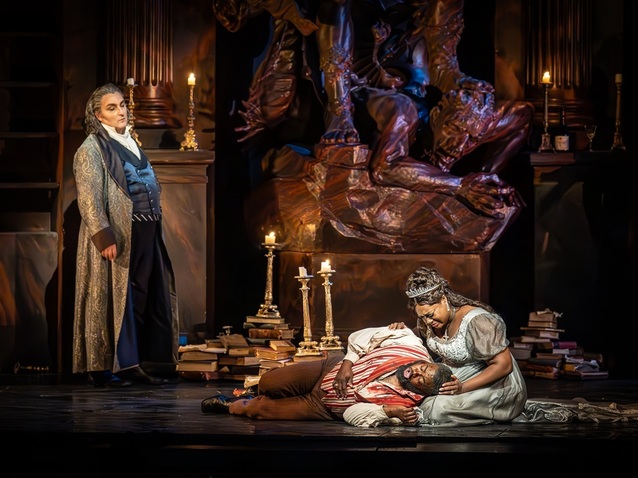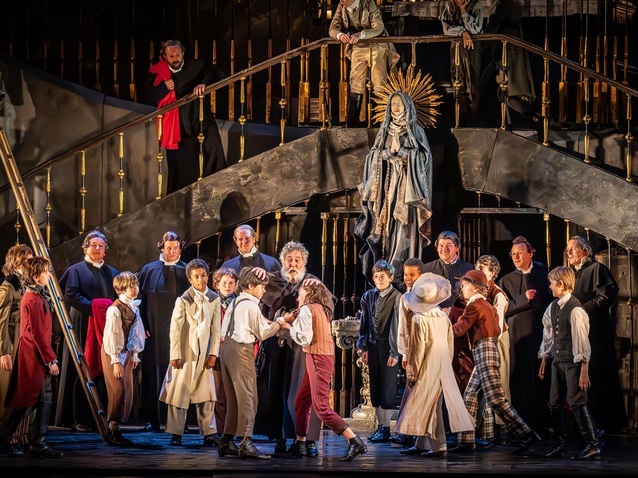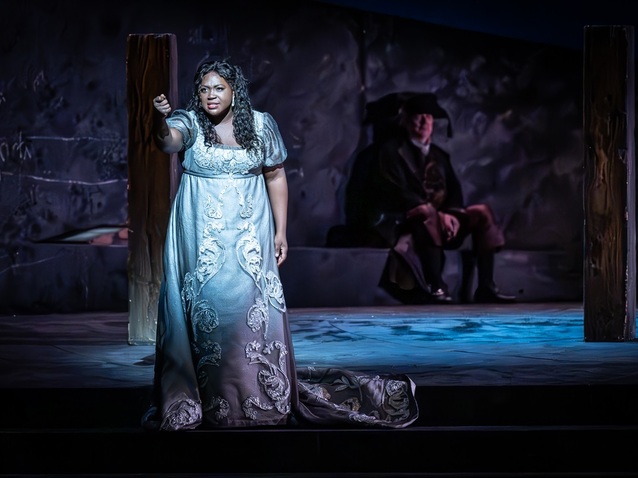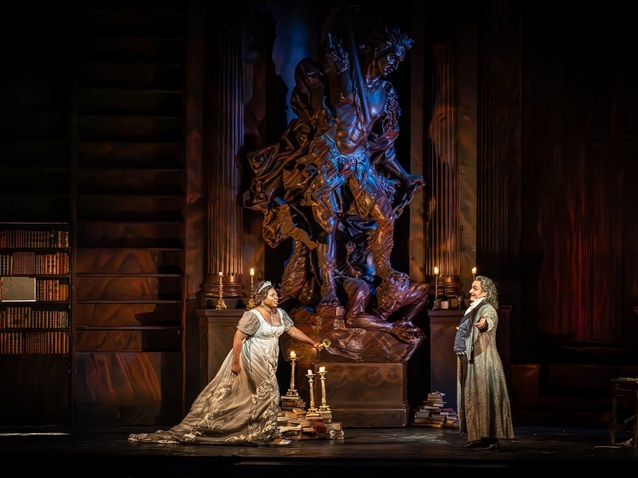 © Marc Brenner
© Marc Brenner
Based on Victorien Sardou’s 1887 French-language play, Giacomo Puccini’s Tosca of 1900, with a libretto by Luigi Illica and Giuseppe Giacosa, not only occurs in a specific time and place, but on a precise date that can be linked to an historical event. All of the action takes place during the afternoon, evening and early morning of 17 and 18 June 1800, following the Battle of Marengo between Napoleon’s army and Austrian forces. The Austrians were initially triumphant and sent news of victory back to Rome, but the city’s celebrations were cut short when a later report revealed that Napoleon subsequently mustered reinforcements and actually inflicted a crushing defeat.
Tosca is set across the hours when the contradictory messages arrive in Rome. Angelotti, a consul of the city when it was a republic but a prisoner since Neapolitan forces began to occupy it, escapes from the Castel Sant’Angelo and turns to the painter Cavaradossi to hide him. Rome’s Chief of Police, Baron Scarpia, attempts to squeeze information as to Angelotti’s whereabouts from Cavaradossi’s lover, the celebrated singer Floria Tosca. She is naturally prone to jealousy and Scarpia exploits this, as well as the situation as a whole in order to fulfil his own desire for her.
After Scarpia sentences Cavaradossi to death for hiding a fugitive, Tosca promises to give herself to the Chief if he will release her lover and allow both of them to leave Rome. Scarpia agrees, explaining that he still needs to appear to have killed Cavaradossi, and so instructs his agent Spoletta to stage a mock execution by telling him to do as they did with Count Palmieri. As soon as Scarpia has written out their passport, however, Tosca stabs him to death. At the subsequent execution she discovers all too late that the Chief tricked her, and that Cavaradossi was shot with real bullets. As news of Scarpia’s murder spreads Tosca leaps off the parapet of the Castel Sant’Angelo and plunges to her death.

Cast of Tosca © ROH 2024. Photo Marc Brenner
Jonathan Kent’s production for the Royal Opera House, which started life in 2006 and is now enjoying its thirteenth revival (from Peter Relton), brings out the tragedy to the full as it sees every set work around some form of curve. Act I presents the shadowy side of Rome’s Sant’Andrea della Valle, with the Attavanti chapel where Angelotti initially hides lying both behind and beneath the church’s main altar. From the audience’s vantage point the nave and chancel stand above the stage, with marble columns and candles proclaiming beauty and light. In contrast, the lower level offers a ‘behind the scenes’ glimpse of the church, where different artistic and architectural styles vie for attention. There is an ancient Corinthian capital, upon which a statue of the Madonna stands, while the painting Cavaradossi is working on appears opposite the faded remains of a medieval Last Judgment fresco, which was presumably painted on a wall that survives from an earlier church on the site.
It is within this more cluttered area that the church as an institution is shown to be imperfect, which in the context of the Neapolitan occupation derives from its virtual inseparability from police and state. During a recitation of the ‘Te Deum’ when the choir and crowd sing to the heavens above, Scarpia alone occupies the entire lower level revealing how, in practice, he rules over all three of these domains.
The late Paul Brown’s set actually places the church at a slight angle to the auditorium, and this asymmetrical trend is continued in Act II when Scarpia’s apartment in the Palazzo Farnese is based around two curves that cross one in front of the other. Interestingly, the only shelves to bear books at all are those that hide the room where Cavaradossi is tortured and even these turn out to be fake. Act III’s scene of execution on top of the Castel Sant’Angelo is dominated by a low curved parapet that only runs down one side of the stage, and creates a suitably hostile moonlit area, courtesy of lighting designer Mark Henderson.

Angel Blue (Tosca) Tosca © ROH 2024. Photo Marc Brenner
Good though it is, the production will be something of a known quantity to many people, which means that the real draw of this revival is the strength of the cast. As Tosca, Angel Blue reveals a very full soprano that possesses a certain glistening quality, but overall comes across as extremely rounded. Her performance of ‘Vissi d’arte’ is particular moving, and the aria’s ending feels as accomplished as any that one is ever likely to hear. Some Toscas are as demanding as they think they can afford to be, given that they know they are naturally alluring so that no-one will readily be turning their back on them. Blue, however, reveals more subtlety by always rolling back a little whenever she begins to push too much. This is partly because she shows how Tosca is ultimately a good person who is not going to be so unkind to Cavaradossi, but also because the jealousy she experiences does not derive simply from expectancy on her part. She genuinely feels vulnerable because she really loves the painter, as illustrated by the way in which she seems filled with joy when he reaffirms his feelings for her.
As Cavaradossi, Russell Thomas reveals a large, secure and persuasive tenor, and his performance of ‘Recondita armonia’ is the first real highlight of the evening. If his ‘E lucevan le stelle’ could ideally be just a little more free flowing, there is never any reason to doubt the overall quality of his performance as Thomas reveals how Cavaradossi’s support for the ideals of the republic is a fundamental part of his very being. Ludovic Tézier is a tremendous Scarpia, with his powerful baritone clearly being heard above the mass of voices in the ‘Te Deum’. Tézier makes the Chief of Police feel quite a distinguished figure, which if anything only makes his behaviour more disconcerting as his brutality does not always feel quite as shocking as it should. The sheer extent to which he has become obsessed with Tosca comes across very clearly, and, in addition to the most obvious moments, there are many points when the tension between the two is palpable such as when Tosca departs in Act I and Scarpia offers her a small, polite bow.

Angel Blue (Tosca) and Ludovic Tézier (Scarpia) Tosca © ROH 2024. Photo Marc Brenner
On his Royal Opera House debut, Andrea Battistoni’s conducting proves to be something special as he brings out the emotion and drama that is inherent in the score to a remarkable degree, and so skilfully that the music always seems to flow naturally. For example, as the soldiers march on at the end to shoot Cavaradossi he simultaneously captures in the sound the routine nature of their business from their own point of view, the fear felt by Tosca despite believing everything will be all right, and our own absolute sense of impending doom. Then after the painter has fallen, Battistoni maximises on the ways in which the same basic tune now feels far more ‘dysfunctional’.
As the Sacristan, Jeremy White seems as exasperated with Cavaradossi as he is frightened of Scarpia, while Colin Judson’s Spoletta also reveals to the full his fear of his own ‘boss’. As Angelotti, Christian Federici applies many thoughtful touches to his performance, gazing on Cavaradossi’s painting as he recognises the image’s similarity to his sister, and revealing a bad leg that explains why he does not escape from the church sooner. Some of the later performances in the current run see Sonya Yoncheva sing Tosca, Yusif Eyvazov play Cavaradossi and Aleksei Isaev take on Scarpia. Jonathan Kent’s Tosca also returns to the Royal Opera House in November and December 2024 with Yoncheva, SeokJong Baek and Bryn Terfel assuming the principal roles.
By Sam Smith
Tosca | 1 - 21 July 2024 | Royal Opera House, Covent Garden
the 06 of July, 2024 | Print
Comments